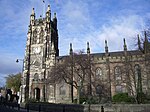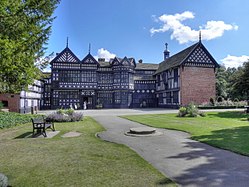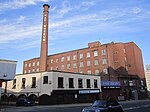 Wear Mill | |
Location in Greater Manchester | |
| Cotton | |
|---|---|
| Spinning (Mule mill) | |
| Location | Cheadle Heath, Greater Manchester |
| Owner | John Collier |
| Further ownership |
|
| Coordinates | 53°24′30″N2°09′55″W / 53.4084°N 2.1654°W |
| Construction | |
| Built | 1790 |
| Renovated |
|
| Equipment | |
| No. of looms | 900 (1892) |
| Mule Frames | 60,000 spindles (1892) |
Listed Building – Grade II | |
| References | |
| [1] | |
Wear Mill (also known as Weir Mill) was an integrated cotton works on the Cheadle Heath bank of the River Mersey in Stockport, Greater Manchester, in England. It was started around 1790 and added to, particularly in 1831 and 1884. In 1840 the Stockport Viaduct was built over the river and over Wear Mill.







